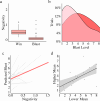Both partners' negative emotion drives aggression during couples' conflict
- PMID: 39242859
- PMCID: PMC11331989
- DOI: 10.1038/s44271-024-00122-4
Both partners' negative emotion drives aggression during couples' conflict
Abstract
Researchers examining conflict between intimate partners believe that the experience and expression of emotion drives aggressive behaviour. Intra-personally, increases in negative affect make aggression more likely. Inter-personally, theoretical models suggest that each individuals' perception of their partners' emotion also influences aggression, potentially creating a Violence Escalation Cycle. Here, using a lab-based aggression task across a primary study (n = 104, number of trials = 3095) and a replication (n = 58, number of trials = 3167), we show that both intra- and inter-personal experiences of negative emotion predict reactive aggression within couples, revealing retaliation but not escalation. Critically, analyses of facial affect reveal that prototypic displays of negative emotions have a compounding effect, leading to dramatic changes in aggression depending on whether one, both, or neither partner expressed negative emotion. We propose a mechanism by which temporal delays (i.e., experimentally imposed forced breaks) reduce aggression by decreasing negative emotional arousal and limiting impulsive action. Our results show that both forced breaks and elective breaks (i.e., extra participant-initiated extensions of the forced break time) reduce aggression, providing exciting evidence that interventions focused on preventing impulsive action when people are in a provoked state can reduce aggression within couples.
© 2024. The Author(s).
Conflict of interest statement
The authors declare no competing interests.
Figures









References
-
- Birkley, E. L. & Eckhardt, C. I. Effects of instigation, anger, and emotion regulation on intimate partner aggression: examination of “perfect storm” theory. Psychol. Violence9, 186–195 (2019). 10.1037/vio0000190 - DOI
-
- Bresin, K. Impulsivity and aggression: a meta-analysis using the UPPS model of impulsivity. Aggress. Violent. Behav.48, 124–140 (2019). 10.1016/j.avb.2019.08.003 - DOI
-
- Hoaken, P. N. S., Shaughnessy, V. K. & Pihl, R. O. Executive cognitive functioning and aggression: Is it an issue of impulsivity? Aggress. Behav.29, 15–30 (2003). 10.1002/ab.10023 - DOI
-
- Blake, K. R., Hopkins, R. E., Sprunger, J. G., Eckhardt, C. I. & Denson, T. F. Relationship quality and cognitive reappraisal moderate the effects of negative urgency on behavioral inclinations toward aggression and intimate partner violence. Psychol. Violence8, 218–228 (2018). 10.1037/vio0000121 - DOI
LinkOut - more resources
Full Text Sources
Miscellaneous
